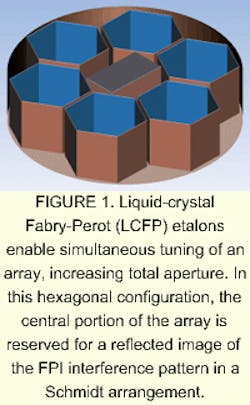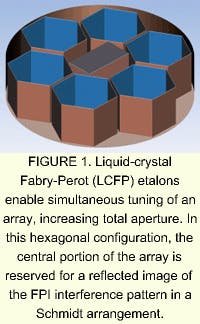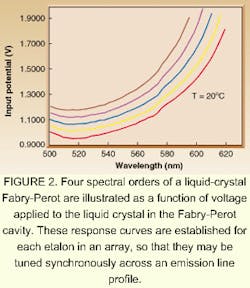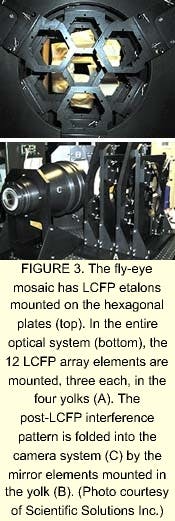Fly-eye design advances atmospheric remote sensing
Robert B. Kerr
Environmental monitoring of atmospheric regions above the tropopause (at about 12-km altitude) has been an international initiative since the dawn of the space age. Accurate measurements of the upper atmosphere become increasingly important as human activity, either by a manned or robotic presence, in this near-Earth space environment becomes more commonplace. Satellite decay, spacecraft charging, communications integrity, weapons performance, greenhouse gas abundance, and surveillance reliability are examples of modern issues that drive commercial, defense, and basic research interests in upper atmospheric monitoring. Parameters of interest in atmospheric sensing include composition, temperature, and wind velocity. The latter two parameters demand ultrahigh spectral resolutions to resolve Doppler features in natural emissions from atmospheric gases with characteristic temperatures as low as 180 K.
Today, optical atmospheric monitoring is on the cusp of a revolution due to the confluence of technological advances in electro-optics, holographic optical elements, and detectors. In particular, the efficacy of the Fabry-Perot interferometer for fast Doppler detection, for use as an element of multispectral imagers, and for robust service at remote ground-based sites and on orbital or suborbital platforms, has been greatly enhanced. Electronic index-of-refraction tuning in the Fabry-Perot cavity has now eliminated the classical aperture limit of the Fabry-Perot interferometer, so sensitivity increases 100 times, made possible by aperture enhancement alone.
The problem: too few photons
The challenge of upper atmospheric remote sensing is illustrated by common measurements of the airglow emission from atomic oxygen at 630 nm. Arising from photochemistry 300 km above Earth's surface, this emission is roughly 20 times dimmer than the threshold of the naked eye, but is frequently used to determine temperature and winds at the orbital altitude of the space shuttle. The thermospheric linewidth at 1000 K is typically about 0.0036 nm, and a typical wind speed is 100 m/s, corresponding to a line-center Doppler shift of 0.00021 nm. A common experimental configuration uses a spectral resolution of 0.0015 nm to sample the line profile. Because a resolution element within the line profile may contain less than 1/50 of the number of photons required for naked-eye visibility, thermospheric temperatures and winds are usually measured with integration periods of a few minutes.
In fact, the 630-nm atomic-oxygen emission is rather bright compared to many terrestrial airglow signatures. Hydrogen atoms fluorescing sunlight from altitudes above 500 km generate the Balmer-alpha (656.3 nm) airglow emission. The Balmer-alpha line profile can be quite distorted, reflecting the velocity distribution of hydrogen atoms in a noncollisional atmospheric region. The atoms emitting in the red energetic tails of these velocity distributions are actually on escaping trajectoriesand their abundance can be quantified to determine the escape flux of hydrogen atoms from Earth. This parameter has important implications for atmospheric evolution and is another illustration of the need for detection of extremely feeble light levels.
The atoms in the wing of the hydrogen velocity distributions produce light 200 times weaker than one spectral resolution element of the atomic oxygen 630-nm profile, and 10,000 times weaker than that which can be seen with the naked eye. To accurately measure the wings of the hydrogen Balmer-alpha line profile in the airglow, new extremely sensitive optical devices are required.
The fly-eye solution
The Fabry-Perot interferometer (FPI) is the most common instrument used to determine upper atmospheric wind velocities and temperatures because of the intrinsic throughput advantage for ultrahigh spectral-resolution applications. In broad brush, the FPI produces more than 100 times the throughput of a simple grating system for comparable spectral resolution and spatial resolution. The "fly-eye" mosaic is a simple concept designed to enhance the total FPI area (see Fig. 1).
The FPI requires highly polished mirrors, λ/100 or better, facing one another, to operate as an interferometer. Glass substrates polished to this accuracy are limited in size to about 6 to 8 in. in diameter. This FPI aperture limit has existed since remote atmospheric observations with FPIs have been made. A mosaic of etalons can be used to enhance the aperture, but these individual FPI elements must be synchronously tuned to produce the coordinated, enhanced aperture.
Tuning is commonly achieved by altering the refractive index (pressure) of a gas in the FPI resonant cavity, or by fine-tuning the FPI resonant gap width using piezoelectric spacer posts. Neither of these techniques is practical when the requirement is synchronously tuning many FPI etalons in a large array. Both weight and feedback complexities quickly overwhelm pressure-tuned or piezo-tuned systems.
Liquid crystal in the FPI resonant cavity may be tuned precisely by application of an electric field to the liquid crystal. Each liquid-crystal Fabry-Perot (LCFP) etalon in the mosaic is individually calibrated for wavelength as a function of applied voltage, so that the entire array may be tuned to a precise wavelength by simple voltage control of each element (see Fig. 2).
The mechanical design of a fly-eye array of LCFP filters is being developed at Scientific Solutions under the auspices of US Air Force funding (see Fig. 3, top). This prototype device includes 12 individual hexagonal liquid-crystal Fabry-Perot devices, six of which, in parallel, define a resolving etalon with a collecting area of 170 cm2, and six of which, also in parallel, define a second suppression etalon with the same collecting area.
By design, the system augments the collecting area of a single liquid-crystal Fabry-Perot element six times, and establishes two etalons in series, each etalon being composed of six liquid-crystal Fabry-Perot elements. Each element in the resolving array forms a pair with an element in the suppression array. Each of these pairs produce an interference pattern which must be spatially oriented via tip-tilt control to overlay the patterns from the other five pairsproducing a single interference pattern at the detector (see Fig. 3, bottom). The fly-eye system performance has been successfully demonstrated, and has promising application in ground-based environmental sensing (see Fig. 4).
Add holographics
Matt McGill and Richard Rallison of NASA Goddard Space Flight Center (Greenbelt, MD) have recently developed a holographic zone plate that can be used to convert the circular Fabry-Perot interference pattern to a series of points (see Laser Focus World, March 2001, p. 131). That holographic circle-to-point innovation simplifies spectral line-profile sampling at the detector end, permitting simultaneous acquisition of many spectral resolution elements across an entire line profile. The holographic circle-to-point innovation, in tandem with high-quantum-efficiency detectors, can enhance FPI sensitivity 50-fold compared to traditional line-profile scanning systems. Conversely, the fly-eye liquid-crystal-Fabry-Perot innovation operates at the input end of the FPI system, and practically enhances the FPI collecting area to any size required by the user.
Implementation of the holographic circle-to-point innovation with the fly-eye design will provide data with unprecedented temporal resolution and spectral sensitivity, a central requirement for untangling the detailed physics of the variability and inter-region coupling of Earth's atmosphere.
ACKNOWLEDGMENTS
Fly-eye liquid-crystal-Fabry-Perot development is funded by Small Business Innovative Research grants: the US Air Force grant USAF F19628-99-C-0019, and the National Science Foundation grant NSF DMI-0079163. The NSF funds atmospheric remote-sensing applications under grants ATM 971 4666 and ATM 971 4916.
ROBERT B. KERR is chief executive officer of Scientific Solutions Inc., North Chelmsford, MA 01863; e-mail: [email protected].



